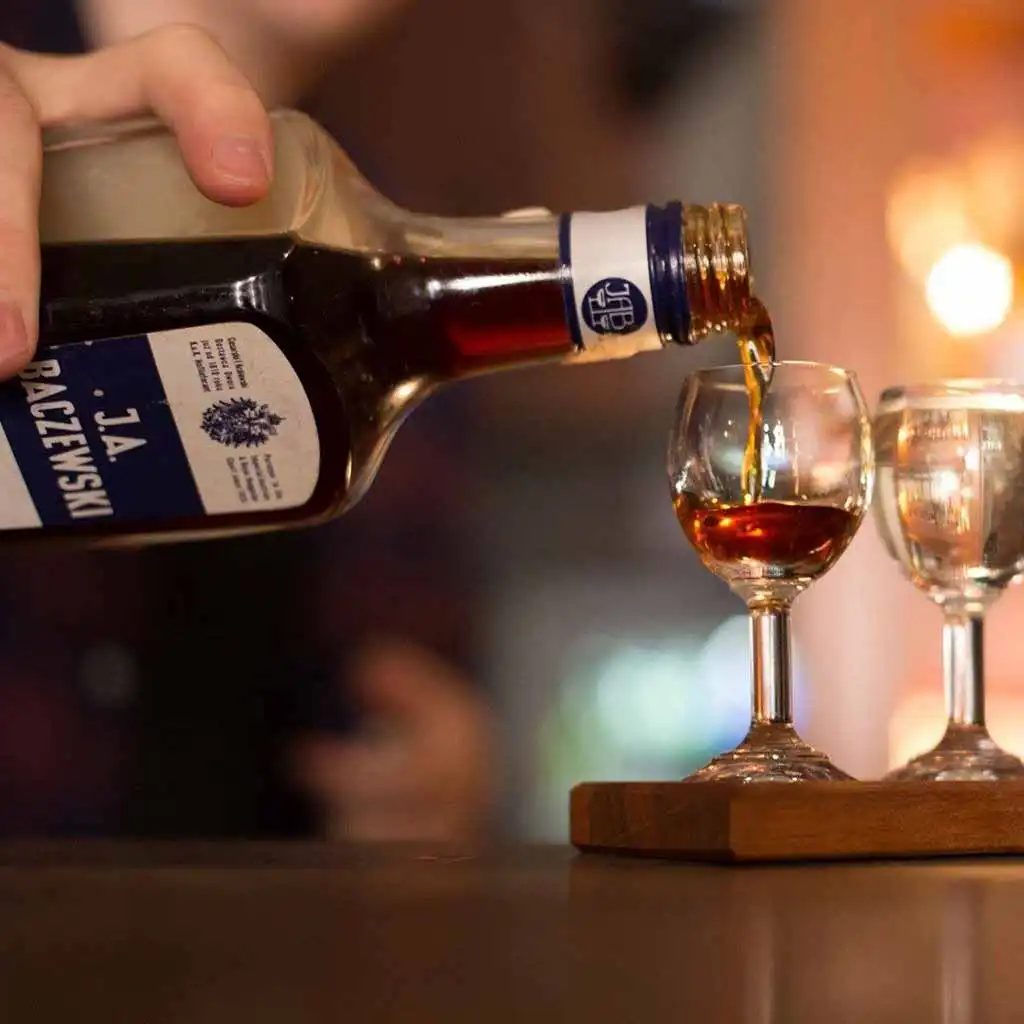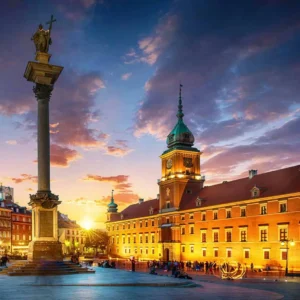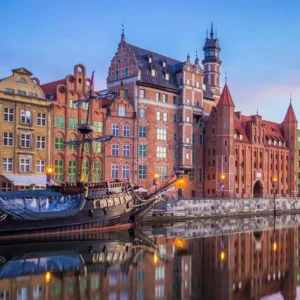The Polish vodka, or “polska wódka” as Poles call it, is more than just a spirit. It’s a profound symbol of national identity, a cornerstone of social gatherings, and a liquid embodiment of a country’s rich history. From its medieval origins as a crude medicinal “gorzałka” (burning water) to its modern status as a protected geographical indication, the story of this potent spirit links inextricably with the Polish psyche.
This article delves deep into the world of Polish vodka, providing travelers and enthusiasts with a comprehensive guide to its history, production, and cultural significance. We will explore the strict legal definitions that set it apart, the meticulous alchemy of its creation, and the nuanced differences between its many forms. Prepare to discover why polish vodka is a must-try for any visitor to Poland and a pivotal part of the country’s cultural landscape. This isn’t just a travel guide; it is an educational journey into the heart of a nation’s most cherished spirit.
The Storied Past: A Journey Through the History of Polish Vodka
To appreciate Polish vodka, you must first understand its long journey. This history is marked by innovation and political turmoil. It also shows cultural integration. Unlike other spirits with singular origins, vodka’s story is shared across Eastern Europe. But Poland has a unique claim to its development. The word “wódka” was first documented in Poland in 1405. Court documents in Sandomierz noted it.
However, it was very different from the modern spirit. The drink was a “burning water” meant to purify and heal. It was not a social drink. This history provides crucial context. It helps you understand the cultural weight of Polish vodka today. It acts as a historical thread connecting generations.
From Medicine to Mainstay: The Medieval Origins of ‘Gorzałka’ (Burning Water)
Polish distillation’s origins go back to the Middle Ages, when people viewed the process differently. Alchemists and monks primarily used distillation to create elixirs for medicinal purposes. This early form of the spirit, known as ‘gorzałka,’ was a potent, unrefined liquid. People believed it had curative properties and used it to treat ailments and as an antiseptic. The focus was not on flavor or social consumption but on its perceived therapeutic benefits. A shroud of mystique covered the act of distilling, and people considered it a form of alchemy, transforming raw materials into a powerful, clear liquid. This is the very beginning of the journey of Polish vodka, where its initial purpose was rooted in health and well-being rather than recreation.
The Birthplace of Distillation: Early Records and Monastic Innovations
Historical records show that Polish monks were at the forefront of early distillation techniques. They leveraged their knowledge of herbs and botany to create flavored, medicinal spirits. The first written recipes and instructions for distillation appeared in Polish texts during the 16th century, signaling a shift from a purely mystical process to a more codified, scientific one. These early distillers, often working in monasteries or on noble estates, laid the groundwork for the future of the industry.
They experimented with different raw materials—primarily rye, a staple grain in the Polish diet—and refined their techniques, slowly transitioning the product from a bitter, medicinal tincture to a more palatable beverage. This period marks the beginning of vodka’s evolution from a niche product to a widely produced commodity. Poland’s abundant rye fields and potato crops provided the perfect foundation for this emerging industry, which would soon become central to the country’s economy.
The Golden Age of the Szlachta: The Role of Vodka in Noble Households
The 16th and 17th centuries were the “Golden Age” for the Polish nobility, the ‘szlachta,’ and it was during this time that vodka truly became a part of the cultural fabric. Noble estates, known as ‘folwarki,’ had their own distilleries, and vodka became a symbol of status and hospitality. Hosts would present their guests with their own unique, often flavored, vodkas. This was the era of ‘nalewki’—a type of liqueur made by macerating fruits, herbs, and spices in vodka.
The spirit was consumed at feasts, celebrations, and important social gatherings. The production of polish vodka on these estates was not just a business; it was a matter of pride and a competitive art form. This period saw the development of various techniques and recipes, with each noble family vying to produce the smoothest, most flavorful vodka. It was a time when the spirit moved beyond its medicinal past and became a crucial part of social life and the Polish identity.
The Rise of a National Industry: Commercialization and Prohibition
The 18th century brought a new era of commercialization. Distilleries began to appear in towns and cities, transitioning vodka production from a rural, noble pursuit to a burgeoning national industry. However, this growth was not without its challenges. Political shifts, including the partitions of Poland, led to periods of foreign control and state monopolies, which significantly impacted the industry. The 19th century was particularly transformative, with the introduction of new technologies like the continuous column still, which allowed for larger-scale production of a purer, more neutral spirit. The industry faced a brief but significant setback during the 20th century with the implementation of a national prohibition, but this only underscored the spirit’s deep roots in Polish culture. Despite these obstacles, the reputation of polish vodka as a high-quality product continued to grow, setting the stage for its modern recognition.
The Monopoly of Kings: Royal Control and the Growth of Distilleries
As vodka production expanded, monarchs and governments recognized its potential as a source of revenue. The “monopoly of kings” was a system where the state controlled the production and sale of alcohol, ensuring a steady stream of income. This control led to a more standardized and regulated industry. While it limited the smaller, more artisanal distillers, it also promoted the growth of large-scale, professional operations. These state-controlled distilleries, often located in major cities, played a significant role in industrializing the production of polish vodka and creating a uniform product for a wider market. This centralization helped establish vodka as a nationally recognized product, rather than just a regional one.
The Soviet Era and State-Run Production: Standardizing a National Treasure
Following World War II, under communist rule, the Polish vodka industry was nationalized. State-run distilleries became the norm, and production was focused on meeting quotas and creating a consistent, standardized product. Brands like Żubrówka and Wyborowa gained international recognition during this period, but the focus was on quantity and efficiency rather than on small-batch craftsmanship. The state monopoly ensured that vodka was widely available and affordable, solidifying its place as the national spirit. While this period lacked the artisanal flair of the pre-war era, it was crucial in cementing polish vodka’s global reputation and establishing the large-scale infrastructure that remains in use today. It was a time of uniformity, where the essence of the spirit was preserved through standardization.
Post-1989: The Return to Tradition and the Rise of Craft Distilleries
After the fall of communism in 1989, the Polish vodka market was privatized, leading to a resurgence of traditional methods and a new wave of craft distilleries. This era has seen a return to the small-batch, quality-over-quantity ethos of the szlachta. Distillers are now experimenting with single-origin grains, unique filtration techniques, and innovative flavor profiles, all while adhering to the country’s strict legal definitions. This post-communist renaissance has breathed new life into the industry, attracting a new generation of drinkers who appreciate the subtleties and craftsmanship behind each bottle. This is a dynamic time for polish vodka, as tradition and modernity converge to create a truly world-class spirit.
The Law and the Land: Understanding the Protected Geographical Indication
A significant factor that distinguishes polish vodka from its counterparts is the law. In 2013, a law was passed that officially defined what can be called “Polska Wódka” or “Polish Vodka.” This legal protection, a Protected Geographical Indication (PGI), is a testament to the country’s commitment to preserving its distilling heritage and ensuring a standard of quality. This protection, similar to that for Champagne or Scotch whisky, guarantees that the product in your hands is a genuine article, made according to specific, historical methods. This law is a crucial piece of the puzzle, a formal acknowledgment of the historical and cultural significance of the spirit, and an assurance for the consumer. It is a vital piece of good to know and must know information for anyone interested in the topic.
What Exactly is “Polish Vodka” (Polska Wódka)?
The legal definition of Polish Vodka is stringent and precise. According to the law, “Polska Wódka” or “Polish Vodka” must be made from ethyl alcohol of agricultural origin, which producers get from five traditional Polish grains—rye, wheat, barley, oats, and triticale—or from potatoes. Importantly, Polish soil must grow all these raw materials. Furthermore, all production stages, from mashing the raw materials to the final bottling, must take place within the Republic of Poland.
This is a very specific and important detail. It means that polish vodka is a product of its land and its people, a true embodiment of Polish terroir. This is not just a marketing gimmick; it is a legally binding commitment to authenticity that sets it apart from many other global brands. When you buy a bottle with the PGI label, you are buying a piece of Polish heritage, guaranteed by law.
Polish Vodka Did you know?
The “5+1” rule for Polish Vodka refers to the five grains (rye, wheat, barley, oats, and triticale) and the one vegetable (potatoes) that are the only permitted raw materials for a spirit to be labeled as “Polska Wódka.” This is a unique and defining characteristic of the PGI law.
The European Union’s Seal of Authenticity: Why PGI Matters
The Protected Geographical Indication (PGI) status, granted by the European Union, is more than just a label. It is a guarantee of quality and authenticity. It protects a product’s name and reputation, ensuring that only products meeting specific criteria can bear the name. For polish vodka, this means that a bottle labeled “Polska Wódka” must adhere to the strict legal definition. This provides a clear distinction for consumers, allowing them to confidently choose a product that is truly and genuinely Polish.
It prevents misuse of the name and helps to preserve the traditional production methods that have been passed down through generations. This protection is a powerful tool in a competitive global market, safeguarding a national treasure and promoting the high standards of the Polish distilling industry. The PGI is a promise of quality and a celebration of origin, reinforcing the idea that polish vodka is a product of a specific place, with a specific history.
The Strict Rules: Defining the Raw Materials and Production Process
The legal framework goes beyond just the raw materials. It also dictates the production process. The spirit must be produced entirely within Poland. This includes the fermentation of the mash, the distillation of the liquid, and the final bottling. Furthermore, no additives other than water are allowed in unflavored “Polska Wódka.” This ensures that the taste and character of the final product come exclusively from the quality of the raw materials and the skill of the distiller. This uncompromising approach to purity is a hallmark of the Polish vodka tradition. The law even specifies the minimum alcoholic strength and sets limits on fermentation by-products, ensuring a clean and pure spirit. This level of detail and control is what makes genuine polish vodka a product of such high quality and a testament to the expertise of its makers.
The “5+1” Rule: The Grains and Potatoes that Define Purity
As mentioned, the “5+1” rule is a defining characteristic of the PGI. Let’s delve deeper into these raw materials. The five grains—rye, wheat, barley, oats, and triticale—each contribute a unique flavor profile to the final spirit. Rye often provides a spicy, robust character; wheat contributes a lighter, sweeter note; and barley, oats, and triticale each add their own subtle complexities. However, what truly sets some polish vodka apart is its use of potatoes. Potato vodka, once considered the mark of a lower-quality spirit, has been reclaimed by modern distillers who celebrate its creamy, full-bodied texture and subtle earthy notes. The “5+1” rule is not just a regulatory requirement; it is a celebration of the agricultural richness of Poland, highlighting the bounty of its fields and the variety of its distilling traditions.
Uncompromising Standards: The Importance of a Single Distillation Site
A key element of the PGI is the requirement that all production stages must take place in Poland. This means the entire process, from the initial mashing of the grains or potatoes to the final bottling, must be done within the country’s borders. This is a significant point of differentiation from many other vodkas, which may be distilled in one country and bottled in another. This “single-site” requirement for polish vodka ensures a high level of quality control and traceability. It reinforces the connection between the spirit and its place of origin, a bond that is central to the PGI concept. This attention to detail demonstrates the seriousness with which Poland takes its national spirit, treating it not just as a product but as a cultural artifact that must be protected and preserved.
The Alchemy of Production: From Field to Bottle
The creation of a great polish vodka is a fascinating process that blends traditional knowledge with modern technology. It is a journey that begins in the fertile fields of Poland and ends in a perfectly crafted bottle. While the PGI sets the legal framework, it is the master distillers’ artistry and expertise that truly bring the spirit to life. This section will walk you through the key stages of production, from the selection of raw materials to the final, crucial step of bottling. It is a detailed look at the craftsmanship that makes polish vodka so special and a must-know for anyone looking to appreciate the spirit on a deeper level. The process is a testament to the blend of science and tradition that has defined Polish distilling for centuries.
Step 1: Selecting the Finest Raw Materials
The journey begins with the careful selection of the finest Polish-grown raw materials. The quality of the grain or potato is paramount, as it forms the very foundation of the vodka’s character. Polish distillers pride themselves on using locally sourced, high-quality ingredients, often from specific regions known for their exceptional produce. For example, rye from certain parts of the country may be prized for its unique flavor profile. This focus on local sourcing is a reflection of the “terroir” concept, the idea that a product’s flavor is influenced by its environment. The choice of raw material—be it a peppery rye or a creamy potato—is the first and most critical decision a distiller makes, setting the stage for the final product’s entire journey.
Grains of Distinction: The Role of Rye, Wheat, and Barley
While all five grains are permitted, rye and wheat are the most common. Rye is celebrated for its spicy, peppery undertones and a dry finish, making for a vodka with a distinct character. Wheat, on the other hand, produces a smoother, sweeter, and more neutral-tasting vodka. The choice of grain is a creative one, allowing distillers to craft spirits with unique flavor profiles. The subtle differences between rye, wheat, and other grains are what make tasting different brands of polish vodka such a rewarding experience. It is a journey of discovery, a way to explore the nuances of Polish agriculture and distilling expertise.
The Humble Potato: A Legacy of Creamy, Earthy Vodka
Potato vodka is a celebrated, and often misunderstood, part of the Polish tradition. It is a spirit of surprising complexity, characterized by a rich, creamy texture and subtle, earthy notes. Distillers consider the process of converting the starch in potatoes to fermentable sugars more complex than with grains, but the result is a truly unique spirit. The flavor of potato vodka depends heavily on the type of potato used and the specific production techniques. Modern craft distillers have embraced the potato, creating premium vodkas that showcase its full-bodied and smooth character. The Polish distilling tradition is a testament to the fact that you can transform a humble vegetable into a world-class spirit, a must-try for any traveler.
Step 2: The Art of Mashing and Fermentation
Once the raw materials are selected, they are mashed and fermented. Mashing is the process of breaking down the starches in the grains or potatoes into fermentable sugars, which is a crucial step that releases the raw material’s full potential. This “mash” is then combined with water and yeast, beginning the fermentation process. The yeast consumes the sugars, producing alcohol and carbon dioxide. This process can take several days and is a critical stage in developing the flavor profile of the spirit. The quality of the yeast and the temperature of the fermentation are meticulously controlled to ensure a clean and consistent product. This is where the science of polish vodka production truly comes into play.
Step 3: Distillation, the Heart of the Process
Distillation is the most important step in creating vodka. It is the process of separating the alcohol from the fermented mash. In Poland, distillers use either pot stills (batch distillation) or column stills (continuous distillation) to achieve their desired level of purity and character. Pot stills, used for more artisanal, small-batch vodkas, produce a spirit with more of the original raw material’s flavor. Column stills, more common for commercial production, can produce a purer, more neutral spirit with a single run. The choice of distillation method is a deliberate one, reflecting the distiller’s philosophy and the desired final product. For example, a distiller aiming for a robust, rye-forward polish vodka might use a pot still to preserve those peppery notes, while a producer of a clean, neutral spirit would favor a column still.
Polish Vodka Fun Fact:
The phrase “wódka” is the diminutive of the Polish word “woda,” which means “water.” This playful name, “little water,” hints at the spirit’s clear appearance and its historical role as a medicinal liquid. It’s a linguistic fun fact that reveals a lot about its cultural roots.
Single vs. Continuous Distillation: Methods and Their Impact on Flavour
The difference between these two methods is significant. Batch distillation, using a pot still, involves heating the mash and collecting the vaporized alcohol in a single run. The result is a more flavorful and less-refined spirit. Continuous distillation, on the other hand, uses a column still with multiple plates. The fermented mash is continuously fed into the still, and as the liquid and vapor move through the column, they are separated into different components based on their boiling points.
This method allows for a much higher level of purity and a more consistent product, which is often a key characteristic of polish vodka. The most important cut in continuous distillation is the separation of the “heads” (undesirable, volatile compounds), the “hearts” (the pure, desirable alcohol), and the “tails” (less-desirable compounds with a higher boiling point). A master distiller’s skill lies in making these precise cuts, ensuring only the purest ‘hearts’ make it into the final product.
Step 4: The Crucial Stage of Filtration
After distillation, we filter the spirit. This process is essential for achieving the absolute clarity and smoothness that Polish vodka is famous for. While many vodkas are filtered through charcoal, Polish distillers may use a variety of materials, including paper, fabric, or even diamonds, to remove any remaining impurities. The filtration process is a delicate balance; it must purify the spirit without stripping it of its character and nuanced flavor notes. The number of times a brand filters its vodka is often a point of pride, as it is a direct indicator of its commitment to purity and quality. This step transforms the raw spirit into a smooth, clean liquid, ready for the final stage.
The Final Step: The Importance of Water and Bottling
The final, and perhaps most underrated, step is blending the high-proof spirit with water. The water’s quality is absolutely critical, as it constitutes about 60% of the final product. Many Polish brands use pristine, demineralized water from deep wells or natural springs, which contributes to the vodka’s smooth and clean finish. Distillers carefully blend the water with the spirit to reach the desired alcohol percentage, typically around 40% ABV. Once bottled, you can enjoy the spirit. The entire process, from the field to the flask, is a testament to the dedication, knowledge, and experience of Polish distillers, who are committed to producing a world-class spirit that truly embodies the essence of Poland.
A Guide to the Types of Polish Vodka for the Discerning Traveler
For a traveler visiting Poland, the sheer variety of vodkas can be overwhelming. Understanding the different types and what to look for can significantly enhance your experience. Polish vodka can be broadly categorized into unflavored and flavored varieties, each with its own history and place in Polish culture. Knowing the difference between them is essential for any tourist who wants to explore the true spirit of Poland. This is one of the most important tips and tricks you can learn before you travel to Poland, as it will open up a new world of taste and cultural understanding. The diversity of the products reflects the richness of Polish traditions.
The Unflavored Purity: Czysta Wódka
‘Czysta wódka’ literally means “pure vodka.” This is the benchmark for quality and a true test of a distiller’s skill. It is an unflavored spirit, with no added sweeteners or other additives, allowing the character of the raw material to shine through. A high-quality ‘czysta wódka’ should be smooth, with a clean finish and no harsh burn. It is the perfect spirit for sipping neat, as it allows you to fully appreciate the subtle notes of the grain or potato it was made from. Brands like Belvedere (made from rye) and Chopin (known for both its rye and potato varieties) are excellent examples of premium Polish ‘czysta wódka’ that showcase the pure essence of the spirit. They are a must-try for any vodka aficionado.
The Flavored Experience: Wódka Gatunkowa
For those looking for a different experience, ‘wódka gatunkowa’ or “flavored vodka” offers a world of unique tastes. These vodkas, often created by macerating fruits, herbs, or spices, have a long history in Poland, tracing back to the ‘nalewki’ of the nobility. Don’t confuse them with cheap, artificially flavored spirits; they are carefully crafted liqueurs with complex and natural flavor profiles. One of the most famous is Żubrówka, or Bison Grass Vodka, which distillers infuse with an aromatic grass found in the Białowieża Forest. This infusion gives the vodka its distinctive yellowish-green color and a delicate, herbaceous flavor. Other popular flavors include ‘wiśniówka’ (cherry vodka) and ‘orzechówka’ (walnut vodka), each with its own regional and historical significance. These flavored spirits offer a delicious and accessible entry point into the world of polish vodka.
The Vodka Taxonomy: Categorizing by Raw Material
A simple yet effective way to categorize polish vodka is by its primary raw material. This taxonomy is a great tips and tricks for anyone trying to navigate the vast selection available in Poland. Here’s a quick guide:
- Rye Vodka: Known for its spicy, peppery, and robust character. It is often described as having a dry finish and a savory profile. A perfect pairing with rich, fatty foods.
- Wheat Vodka: Generally considered to be a sweeter and softer vodka. It is smooth and easy to drink, with a light body and subtle notes of bread or toast.
- Potato Vodka: A unique and creamy spirit. It is full-bodied and has a rich, smooth texture. The flavor is often described as earthy, buttery, and slightly sweet. It is a fantastic sipping vodka.
- Other Grains: While less common, vodkas made from barley, oats, or triticale offer their own unique characteristics and are often found in the portfolios of smaller, craft distilleries.
This simple breakdown allows travelers to quickly identify the type of vodka they are drinking and appreciate the subtle differences that each raw material brings to the spirit. This is a must-know for any connoisseur of polish vodka.
The Polish Vodka Ritual: Culture, Customs, and Social Etiquette
Drinking polish vodka is not just about the liquid itself; it is a social ritual, steeped in tradition and etiquette. For visitors, understanding these customs can be the difference between being an outsider and becoming part of the local culture. Poles share their vodka, and the act of drinking it is a way to forge bonds and celebrate life’s moments. This is where the true “program” of a Polish social gathering unfolds, and vodka is at its center. It’s an important part of the travel Poland experience, providing a deeper connection to the local community.
Polish Vodka Fun Fact:
In Poland, it is considered bad luck to toast with an empty glass. The tradition is to make sure everyone has a full shot before raising their glass. This simple gesture of hospitality and shared experience is a cornerstone of Polish drinking culture.
Vodka as a Social Lubricant: The Role of Wódka in Polish Gatherings
In Poland, you don’t typically drink vodka alone; it’s a communal experience. People make it the centerpiece of weddings, holidays, and family dinners. It serves as a social lubricant, breaking down barriers and fostering a sense of camaraderie. They often place the bottle in the middle of the table, and participants take turns pouring for each other. This is a key aspect of Polish vodka culture—it’s about sharing, generosity, and mutual respect. Conversations, laughter, and, most importantly, food punctuate the act of drinking. The communal nature of the experience is what makes it so memorable and a core part of Polish identity.
The Toast: Master the Art of ‘Na Zdrowie’ and Other Expressions
The Polish toast is a formal and important part of the ritual. The most common toast is “Na zdrowie!” which means “To your health!” or simply “Cheers!” It is a phrase you will hear often during your travel in Poland. It is a sign of respect to look the person you are toasting in the eye. Other toasts, or ‘okolicznościowe toasty,’ are made for specific occasions, such as birthdays, anniversaries, or achievements. The toast is more than just a formality; it is a moment to pause, reflect, and show appreciation for those you are with. Mastering this simple phrase and gesture will go a long way in making a good impression and participating fully in a Polish gathering. The toast is the beginning of the “program” of the evening, setting a convivial and friendly tone for the celebration.
Paired to Perfection: The Best Food Pairings for Polish Vodka
The Polish saying “vodka is a spirit, food is its chaser” highlights the importance of pairing polish vodka with food. Drinking on an empty stomach is highly discouraged. The food, known as ‘zakąski,’ serves as a delicious and practical accompaniment. The traditional pairings are often simple but perfect. The acidity of pickled cucumbers and mushrooms cuts through the richness of the spirit, while fatty cured meats and sausages provide a perfect counterpoint to its clean taste.
Herring in oil or sour cream is another classic pairing. This is a must-know tips and tricks for anyone planning to drink vodka in Poland. The food is not just a side dish; it is an integral part of the experience, a way to pace yourself and truly enjoy the moment. The contrast between the cold, smooth vodka and the savory, rich food is a culinary delight, a perfect fusion of taste and texture. This culinary aspect is an essential part of the travel Poland experience.
Polish Vodka Did you know?
Unlike many other countries where people serve vodka with ice, Poles typically drink their vodka chilled, but not frozen, and serve it in a small shot glass. This lets you taste the subtle character of the spirit without the cold numbing it. This is an important distinction and a sign of a true connoisseur.
A Traveler’s Must-Know Guide to Polish Vodka
For the modern traveler, understanding polish vodka means more than just knowing its history and how to drink it. It means knowing where to go to experience it firsthand and how to make the most of your trip. The following information provides must-know tips and tricks for anyone visiting Poland who wants to get a deeper appreciation of the country’s national spirit. This is a crucial “program” for any visitor, guiding them to the best attractions and experiences. These attractions are not just tourist traps; they are a deep dive into the culture and history of the spirit, a must-do for anyone serious about their travel Poland adventure.
The Ultimate Destination for a Vodka Experience: The Polish Vodka Museum
For an unparalleled and educational experience, a visit to the Polish Vodka Museum in Warsaw is an absolute must. Located in the historic, revitalized Praga district, in a former 19th-century vodka factory, the museum offers a comprehensive journey through the history, production, and cultural significance of the spirit. It’s a fantastic attraction that provides a wealth of information in an engaging and interactive format. The museum showcases artifacts, historical documents, and an incredible collection of bottles.
A key highlight is the guided tour, which culminates in a professional tasting session where you can sample different types of polish vodka, from rye to potato, and learn to distinguish their subtle flavor differences. This experience provides an essential E-E-A-T background, showcasing the expertise and authority behind the brand. The museum is a core program in any Warsaw itinerary for a true connoisseur. It’s not just a place to see things; it’s a place to learn, to taste, and to truly understand the spirit.
How to Drink Polish Vodka Like a Local
Drinking polish vodka is an art form. Here are some essential tips and tricks for drinking it like a local:
- Chilled, Not Frozen: As mentioned, vodka is best served chilled from the refrigerator. Freezing it can mask the subtle flavors and aromas that are the hallmark of a high-quality polish vodka.
- The Right Glassware: Always use a small shot glass, typically around 50 ml. The correct glassware is not just for aesthetics; it’s part of the ritual.
- The Art of Sipping vs. Downing: While it is often consumed in one gulp, especially during a toast, high-quality polish vodka is meant to be savored. Try both methods to see which you prefer, but don’t be afraid to sip a truly exceptional spirit. A quick tip is to have a small bite of ‘zakąski’ (a food pairing) after each shot to cleanse the palate and prepare for the next round. This is the “program” for a successful night out.
From Farm to Flask: Meeting the Makers
For the ultimate polish vodka experience, consider visiting a distillery. Many craft distillers across Poland offer tours and tasting opportunities, providing a firsthand look at the production process. On these tours, you can truly connect with the spirit’s “program.” You see the raw materials, the stills, and the hands-on expertise of the makers. These tours also give you a chance to speak with the distillers themselves. This provides an even deeper understanding of their craft and passion. It’s an unparalleled way to gain expertise and a deep appreciation for the spirit. It’s a must-do for anyone who wants to truly explore the world of Polish vodka.
The Future of the Spirit: Modern Trends and AI Innovations
While steeped in tradition, the world of polish vodka is not static. It is a dynamic industry that is constantly evolving, embracing modern trends and even the cutting edge of technology. The rise of craft distilleries is a return to the roots, but the industry is also looking to the future, with AI and data playing a new and interesting role. This section explores how tradition and innovation are coexisting, ensuring the continued relevance and quality of polish vodka in the 21st century. It’s a look at the program for the future of the industry, showing a fascinating blend of old and new.
The Craft Movement: Rediscovering Terroir and Traditional Methods
The craft distilling movement is one of the most exciting trends in the industry today. Small-batch producers are focusing on single-origin grains, heirloom potato varieties, and traditional distillation methods to create spirits with unique and complex flavor profiles. This movement is a direct response to the era of mass-produced, neutral spirits. It is about rediscovering the concept of ‘terroir’ and showcasing the distinct character of the Polish landscape. These distillers are true artisans, dedicated to preserving traditional techniques while also pushing the boundaries of what is possible. They are the new face of polish vodka, blending a deep respect for the past with a forward-looking vision.
A Glimpse into the Future: How AI is Optimizing Vodka Production
The application of artificial intelligence (AI) in the spirits industry is a growing trend. While the art of distilling remains a human endeavor, AI is being used to optimize and perfect the process. This isn’t about replacing the master distiller; it’s about giving them new tools to enhance their craft. AI-powered sensors can monitor fermentation and distillation in real-time, providing distillers with a level of precision that was previously impossible. Algorithms can analyze a vast amount of data, from the quality of the raw materials to the temperature and pressure during distillation, to ensure a consistent and flawless product. This is a fascinating glimpse into the future of the industry, a new program for distilling excellence.
Big Data and Distillation: Using Algorithms to Perfect the Process
Big data analytics creates predictive models. These models anticipate changes in raw material quality. They also adjust the distillation process accordingly. This optimization helps distillers minimize waste. It also reduces energy consumption. Most importantly, it maintains a consistently high quality. By analyzing data on mash sugar content and cooling water temperature, AI helps distillers. It allows them to make micro-adjustments. These adjustments have a major impact on the final product. This is a testament to the fact that even a centuries-old tradition like Polish vodka production can benefit from modern technology.
The Role of AI in Quality Control and Consumer Insights
AI is also playing a significant role in quality control, with advanced vision systems and sensors detecting even the slightest imperfections in the liquid or the bottling process. This ensures that every bottle of polish vodka that leaves the distillery meets the highest standards. Furthermore, AI is being used to analyze consumer data, providing distillers with insights into what flavors and styles are most popular. This allows them to innovate and create new products that appeal to a new generation of drinkers, ensuring the continued relevance and success of polish vodka in a competitive global market. The future of polish vodka is a blend of human artistry and technological precision, a perfect program for success.
Dispelling the Myths: Separating Fact from Fiction
Despite its rich history and legal protections, polish vodka is often misunderstood. Many common myths and misconceptions persist, clouding its true identity and character. This section aims to provide clarity and set the record straight, giving you the knowledge to confidently discuss and appreciate the spirit. It’s a quick guide to some must-know tips and tricks for separating fact from fiction. This is essential for anyone who wants to demonstrate true expertise and authority on the topic and truly understand the brand and the program behind it.
Myth: All Vodkas Are the Same
Fact: This is perhaps the most pervasive myth about vodka. The reality is that the quality, character, and flavor profile of vodka are highly dependent on the raw materials, the distillation method, and the water used. Polish vodka, with its strict PGI rules, is a perfect example of this. The difference between a potato vodka and a rye vodka is as significant as the difference between a single malt scotch and a blended whisky. The idea that all vodkas are interchangeable is a gross oversimplification that ignores the rich diversity and craftsmanship within the category.
Myth: Vodka is a Flavorless Spirit
Fact: While neutral vodka is designed to be as pure as possible, it is not flavorless. A high-quality polish vodka will have subtle notes derived from its raw material. A rye vodka might have a peppery taste, a potato vodka a creamy texture, and a wheat vodka a hint of sweetness. The subtle flavors and aromas are what a true connoisseur looks for. It is the absence of harsh, unpleasant flavors, not the total absence of flavor, that defines a quality spirit. The notion of a completely neutral, tasteless spirit is a misunderstanding of the distiller’s goal, which is to create a clean, but not characterless, liquid.
Myth: Vodka is a Russian Invention
Polish Vodka Fact:
The origins of vodka are debated. Both Poland and Russia claim to be the birthplace. But the word “wódka” was first documented in Poland in 1405. Both countries share a long history with the spirit. However, the claim of a Russian invention is inaccurate.
“Polska Wódka” has unique legal protections. This proves Poland’s distinct tradition. The country’s distilling history stands on its own. Poland’s role in refining the spirit is crucial. The PGI protects this heritage. This history is key to the brand. It is a must-know for enthusiasts.
Frequently Asked Questions About Polish Vodka
What are the main ingredients of Polish Vodka?
Producers must make Polish Vodka from five traditional grains—rye, wheat, barley, oats, and triticale—or from potatoes, all grown in Poland, to meet legal requirements.
What does ‘Polska Wódka’ mean?
‘Polska Wódka’ is the Polish term for “Polish Vodka.” As a legally protected name and a Protected Geographical Indication (PGI), it guarantees its authenticity and origin.
How is Polish Vodka different from other vodkas?
The main difference is the Protected Geographical Indication (PGI) status, which requires that all raw materials must be Polish-grown and all stages of production must take place within Poland’s borders.
What is Żubrówka?
Żubrówka, a famous brand of Polish vodka, is infused with a type of aromatic bison grass found in the Białowieża Forest. It has a distinctive herbal flavor and a yellowish-green color.
Do you drink Polish Vodka with a mixer?
While unflavored Polish Vodka can be used in cocktails, it is traditionally served neat and chilled, without a mixer. The focus is on appreciating the pure flavor of the spirit itself.
Is there a Polish Vodka made from potatoes?
Yes, you can make Polish Vodka from potatoes. Potato vodka is a traditional style known for its distinct characteristics. It is celebrated for its creamy texture, smooth finish, and subtle earthy notes. This unique flavor profile results from the potatoes’ high starch content and the specific distillation methods used to produce it.
What is the best food to pair with Polish Vodka?
You typically pair Polish vodka with savory and fatty foods, which locals call ‘zakąski’. These foods effectively complement the spirit and cleanse your palate. Classic pairings include pickled cucumbers, smoked sausages, herring, and pierogi.
What is the Polish word for “Cheers”?
The most common and traditional Polish word for “Cheers” is “Na zdrowie!” which translates to “To your health!”
Can I tour a Polish Vodka distillery?
Yes, many distilleries in Poland, especially craft producers, offer tours and tasting sessions. The Polish Vodka Museum in Warsaw also offers a comprehensive experience, including a guided tasting.
What does it mean if a vodka is ‘single-distilled’?
To make a vodka “single-distilled,” distillers typically use a pot still in a single run. Craft distillers often use this method to preserve more of the raw material’s unique flavor and character.
Polish Vodka Conclusion: The Final Toast to Polish Vodka
The journey into Polish vodka is fascinating. It’s a spirit with a rich history. Strict legal standards define it. It is also a symbol of Polish national identity. It’s more than a drink, it’s a cultural artifact. A testament to tradition, a symbol of Polish pride.
Its story is one of resilience. The story of refinement. It began as medicine. It became a globally recognized PGI. Its production standards are uncompromising. Its raw materials have distinct character. The social rituals are unique. They make it an exceptional spirit. Experiencing it is a must for travelers. It’s an essential part of your Poland program.
You can choose to sip a pure ‘czysta wódka.’ You can explore the rich flavors of a ‘nalewka.’ You can also delve into creamy potato vodka. You’ll partake in an ancient tradition. It is a tradition that is ever-evolving. Understanding its nuances is key. The PGI and toast are important. This will deepen your appreciation. It transforms a simple drink. It becomes a meaningful cultural exchange.
So, when in Poland, raise a glass. Look your companions in the eye. Toast with a heartfelt “Na zdrowie!” This is more than a travel tip. It’s a way to connect with Poland. You connect with its heart and soul. You do this one sip at a time.
Back to the Polish Adventure!
Your journey is just beginning. Now that you’ve explored the secrets of this article, it’s time to return to your home base. Click the link below to dive back into our comprehensive Best Tips for Poland hub article, where you can find more incredible guides and keep planning your ultimate Polish adventure. We’ve got so much more to show you!


















